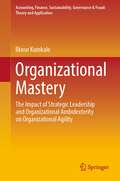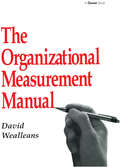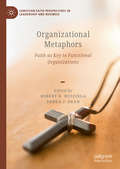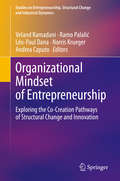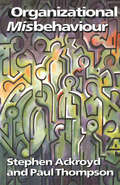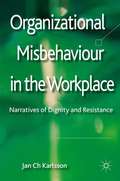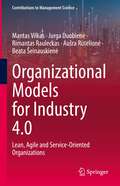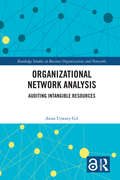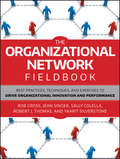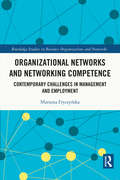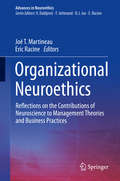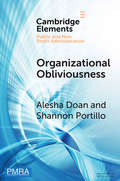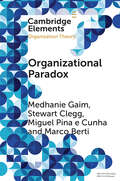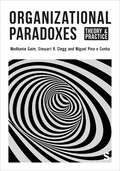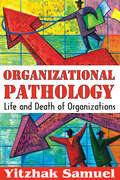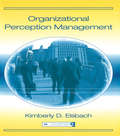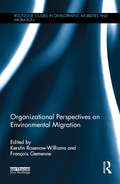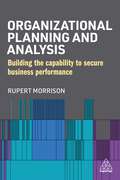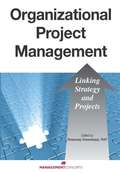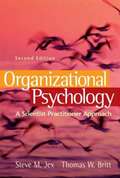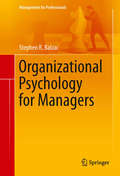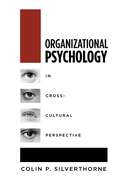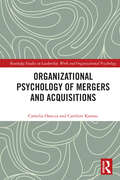- Table View
- List View
Organizational Mastery: The Impact of Strategic Leadership and Organizational Ambidexterity on Organizational Agility (Accounting, Finance, Sustainability, Governance & Fraud: Theory and Application)
by İlknur KumkaleThis book examines the impact of strategic leadership and organizational ambidexterity skills on the strategic agility of a particular organization in four parts. In the first part, the concept of ambidexterity is discussed and the issue of organizational ambidexterity is explained with its dimensions. Exploratory and beneficiary innovation abilities as well as adaptability and alignment are examined as sub-dimensions. In the second part, the concept of strategic leadership is expanded upon, first conceptually and then across five dimensions: managerial strategic leadership, transformational strategic leadership, political strategic leadership, communicative strategic leadership, and ethical strategic leadership. The third part focuses on strategic agility. The beginning of the concept of agility, organizational agility, and the importance of agility are explained across the dimensions of competence, flexibility, responsiveness, and speed. The fourth part focuses on field study, and the results are evaluated by analyzing the data obtained from surveys of managers of large and medium-sized enterprises. This book would be a valuable read for academics, bachelor, and graduate students in managerial sciences and business leaders.
The Organizational Measurement Manual
by David WealleansThe Organizational Measurement Manual is a step-by-step guide to creating performance measurements at the working level. It addresses the procedures for identifying, designing, monitoring and using measurements and how these might relate to other objectives and initiatives within an organization. In so doing it explores the use of general performance measurement as a management tool for the key areas of control, customer satisfaction and business improvement. The book is clearly differentiated from many other publications on the subject of measurement by the firm distinction made between general, strategic measurement that represents an umbrella approach to the quantification of performance and the monitoring of process-level attributes that directly relate to the performance of an individual work team. The benefits of, and best practice approach to, the use of process-level measurements are clearly explained.
Organizational Metaphors: Faith as Key to Functional Organizations (Christian Faith Perspectives in Leadership and Business)
by Robert B. Huizinga Debra J. DeanThis edited volume expands on Morgan's organizational metaphors through the lens of faith to illuminate organizational function. Part I uses metaphor to illustrate dysfunctional organizations, including the impact of dysfunction upon organizational trust, performance, and longevity. Part II examines the progression from a dysfunctional organization to one that exhibits functionality. Finally, the last section discusses healthy organizations. Metaphors used in this book include Pygmalion organizations, organizational zombies, and organizations as vineyards. This book offers new metaphors that can be applied in organizational theory.
Organizational Mindset of Entrepreneurship: Exploring the Co-Creation Pathways of Structural Change and Innovation (Studies on Entrepreneurship, Structural Change and Industrial Dynamics)
by Léo-Paul Dana Veland Ramadani Norris Krueger Ramo Palalić Andrea CaputoThis book focuses on how to promote innovation and an entrepreneurial mindset within organizations in the context of structural changes. It highlights the importance of internal marketing of innovation and ideas among employees, of creating collaborative spaces, and of company leaders promoting collaboration. The key aspect in all contributions gathered here is to understand the co-creation paths of structural change and innovation, and how they contribute to competitive advantage. The respective chapters address topics such as intrapreneurship, organizational mindset, creating an entrepreneurial orientation, strategic leadership, and internal & external organizational networking. All contributions are based on the latest empirical and theoretical research, and provide key findings and concrete recommendations for organizations.
Organizational Misbehaviour: SAGE Publications
by Professor Paul Thompson Stephen Ackroyd'[A] textbook specifically aimed at organizational misbehaviour. ...it certainly fills a gap... containing a large survey of academic literature on the subject. The book is good: it brings to light subjects which are too often negleced, and it provides an understanding of phenomena which are so common in organizations, but at the same time so vague and incomprehensible' Organization Studies From `soldiering' and absenteeism to humour in organizations and the emergence politics of sexuality, this book explores the latest forms of organizational subversion and offers fresh insights of the underlying dynamics of management and organizational processes. The book opens with a critique of orthodox organizational analysis and maps out the wide terrain across which organizational `misbehaviour' occurs. The authors go on to examine the interconnections between identity formation, the pursuit of autonomy and organizational misbehaviour, and explore how clearly the tendency to misbehave is deeply embedded in organizational life.
Organizational Misbehaviour in the Workplace
by Jan Ch. KarlssonEmployees need dignity and autonomy in their workplace. If they are denied this there will be a strong tendency to resist working conditions and misbehave. The theme of this book is how employees try to establish and maintain dignity and itincludes a wealth of gripping, funny and tragic stories about workers' and managers' creative ways of doing that narratives that make us reflect upon how employees are treated at work and the consequences thereof. Jan Ch. Karlsson presents a new model for analyzing these processes in working life. The model integrates themes that have usually been regarded as separate entities, such as organizational misbehaviour, resistance, abusive supervision, discipline in informal self-organised groups at workplaces, and doing private business during working hours. Through this model a fascinating novel perspective is suggested on what is currently happening in the modern workplace. "
Organizational Models for Industry 4.0: Lean, Agile and Service-Oriented Organizations (Contributions to Management Science)
by Mantas Vilkas Jurga Duobienė Rimantas Rauleckas Aušra Rūtelionė Beata ŠeinauskienėThis book draws on a neo-institutional theory to characterize service-oriented manufacturing firms in relation to more familiar organizational forms, such as lean and agile. It sheds light on whether being lean is a prerequisite for agile organizations and whether agile organizations are precursors of service-oriented organizations. The book empirically examines the prevalence of such organizations using representative samples of manufacturing firms in an industrialized country. This approach makes it possible to “zoom in” and determine whether the extent of adoption of digital manufacturing innovations, digital services, and service-oriented business models varies with organizations’ size, industry, product complexity, lot size, type of design process, and type of manufacturing process. In turn, it shows which digital manufacturing innovations, lean practices, and services contribute to leanness-related performance capabilities like quality and costs; agility-related capabilities like fast delivery, flexibility and innovation; and service-oriented capabilities like high service performance and digitalization. In addition, it explores the question of whether lean, agile, and service-oriented performance capabilities contribute to financial performance separately or jointly.
Organizational Myopia
by Maurizio CatinoCould the terrorist attacks on the Twin Towers have been avoided? What about the control failures in the recent global financial crisis? Behind these apparently very different events, it is possible to identify a common element of organizational myopia - a syndrome that severely limits the capacity of organizations to foresee the effects of their own decisions and to recognize signs of danger or opportunity. Organizational Myopia explores the barriers that impede organizations from identifying an effective response to the problems that they have to confront. Using real-world cases, the author investigates the mechanisms that generate myopia in organizations at the individual, organizational, and interorganizational level in contexts that are complex, uncertain, ambiguous, and changeable. This book will help readers understand how to limit the origins of myopia and therefore increase the capacity of organizations to anticipate and contain unexpected events.
Organizational Network Analysis: Auditing Intangible Resources (Routledge Studies in Business Organizations and Networks)
by Anna Ujwary-GilThe integrated meta-model for organizational resource audit is a consistent and comprehensive instrument for auditing intangible resources and their relations and associations from the network perspective. This book undertakes a critically important problem of management sciences, poorly recognized in literature although determining the current and future competitiveness of enterprises, sectors and economies. The author notes the need to introduce a theoretical input, which is manifested by the meta-model. An expression of this treatment is the inclusion of the network as a structure of activities, further knowledge as an activity, and intangible assets as intellectual capital characterized by a structure of connections. The case study presented is an illustration of the use of network analysis tools and other instruments to identify not only the most important resources, tasks or actors, as well as their effectiveness, but also to connect the identified networks with each other. The author opens the field for applying her methodology, revealing the structural and dynamic features of the intangible resources of the organization. The novelty of the proposed meta-model shows the way to in-depth applications of network analysis techniques in an intra-organizational environment. Organizational Network Analysis makes a significant contribution to the development of management sciences, in terms of strategic management and more strictly resource approach to the company through structural definition of knowledge; application of the concept of improvement-oriented audit abandoning a narrow understanding of this technique in terms of compliance; reliable presentation of audits available in the literature; rigorous reasoning leading to the development of a meta-model; close linking of knowledge and resources with the strategy at the design stage of the developed audit model, including the analysis of link dynamics and networks together with an extensive metrics proposal; an interesting illustration of the application with the use of metrics, tables and charts. It will be of value to researchers, academics, managers, and students in the fields of strategic management, organizational studies, social network analysis in management, knowledge management, and auditing knowledge resources in organizations.
The Organizational Network Fieldbook
by Cross Robert L. Jean Singer Sally Colella Thomas Robert J. Yaarit Silverstone"This is the ultimate resource for practitioners who want to implement insights from organizational network analysis and thinking. Dozens of concrete examples, interventions, and practical advice from network experts show you what you can do to strengthen networks and boost performance. This book is essential for anyone in business, government, or consulting who wants to get network thinking from analysis to action in organizations. "-Wayne Baker, professor of management and organizations, Stephen M. Ross School of Business, University of Michigan "What a great idea this book is! The Organizational Network Fieldbook will demand to be read by anyone undertaking any social network efforts in their organization. It is not only a unique book, but it is also very well thought-out, finely written, and exceptionally pragmatic. It's a great achievement for the authors and a great boon to all practitioners. "-Larry Prusak, researcher and consultant, and the founder and former director of the Institute for Knowledge Management In this practical companion to the best-selling Driving Results Through Social Networks, the authors draw on their network-building activities in organizations such as ConocoPhillips, 3M, and the United States Department of Defense in order to provide a compilation of highly practical approaches to help leaders shift their focus from formal organizational structures to a better understanding of flexible networks.
Organizational Networks and Networking Competence: Contemporary Challenges in Management and Employment (Routledge Studies in Business Organizations and Networks)
by Marzena FryczyńskaNetworks and networking are essential concepts that transform organizational, economic, and social practices. Human capital is both a source of competitive advantage and a value that allows individual employees to develop their careers and find satisfaction in their employment. The book addresses the vital issue of changes occurring in management and employment, with the growing career individualization, focus on future professional challenges, importance of knowledge workers, and possibilities of functioning in social and organizational networks. Workers’ networking competence is the main theme of this book. Much attention is put on differentiating it from other types of competence and other network objects, and identifying its behavioral manifestations, as the frequency of such behaviors can be used as a measure of an individual’s networking competence level. Employment-related variables and characteristics that affect networking competence are analyzed in depth, as is the impact of networking competence on career success and employability — thus laying a foundation for transformation in network organization management, employee relations, and individual career development. It will be of interest to researchers and students alike, as it clearly demonstrates a way to solve research problems in management science and provides new instruments for further research on networks and networking; and to organization managers and employees, as it offers insights into management and employment-related trends as well as guidelines for managing network organizations and building one’s career within social and organizational networks.
Organizational Neuroethics: Reflections on the Contributions of Neuroscience to Management Theories and Business Practices (Advances in Neuroethics)
by Eric Racine Joé T. MartineauUnderstanding and improving how organizations work and are managed is the object of management research and practice, and this topic is of longstanding interest in the academia and in society at large. More recently, the contribution that the study of the brain could make to, notably, our understanding of decisions, emotional reactions, and behaviors has led to the emergence of the field of “organizational neuroscience”. Within the field of management, organizational neuroscience seeks to explore linkages between neuroscience research, theories, and methods and management research. Its primary goal is to incorporate findings on the cognitive processes underlying the thoughts, behaviors and attitudes of organizational actors in order to better inform management theories, and to assist in understanding, predicting and improving these behaviors in the workplace. As a result, we have seen in the last decade a flurry of research projects and publications in organizational neuroscience, as well as novel or rejuvenated innovations around neuromarketing, neuroleadership, and cognitive enhancement in the work place, to name a few. However, research and practical applications in organizational neuroscience pose profound ethical challenges about, for example, organizational responsibility in the responsible use of scientific innovation. Drawing on recent debates in the field, and in response to upcoming ethical challenges of organization neuroscience, this book introduces “organizational neuroethics” as an emerging interdisciplinary field that addresses the ethics of organizational neuroscience research and applications, as well as the neuroscience of organizational ethics. The first part focuses on the ethics of organizational neuroscience and several chapters tackle the ethics of neuromarketing or neuroleadership and discuss the ethical issues associated with neuroenhancement practice in the workplace. The second part of the book addresses cutting-edge topics in the neuroscience of organizational ethics. Written by international experts in the fields of management, neuroscience, ethics, and social science, this book will be of prime interest to practitioners, researchers and students in the various fields concerned with improving management research and practices, as well as organizational ethics.
Organizational Obliviousness: Entrenched Resistance to Gender Integration in the Military (Elements in Public and Nonprofit Administration)
by Alesha Doan Shannon PortilloExploring efforts to integrate women into combat forces in the military, we investigate how resistance to equity becomes entrenched, ultimately excluding women from being full participants in the workplace. Based on focus groups and surveys with members of Special Operations, we found most of the resistance is rooted in traditional gender stereotypes that are often bolstered through organizational policies and practices. The subtlety of these practices often renders them invisible. We refer to this invisibility as organizational obliviousness. Obliviousness exists at the individual level, it becomes reinforced at the cultural level, and, in turn, cultural practices are entrenched institutionally by policies. Organizational obliviousness may not be malicious or done to actively exclude or harm, but the end result is that it does both. Throughout this Element we trace the ways that organizational obliviousness shapes individuals, culture, and institutional practices throughout the organization.
Organizational Paradox (Elements in Organization Theory)
by Medhanie Gaim Stewart Clegg Miguel Pina e Cunha Marco BertiParadoxes, contrary propositions that are not contestable separately but that are inconsistent when conjoined, constitute a pervasive feature of contemporary organizational life. When contradictory elements are constituted as equally important in day-to-day work, organizational actors frequently experience acute tensions in engaging with these contradictions. This Element discusses the presence of paradoxes in the life of organizations, introduces the reader to the notion of paradox in theory and practice, and distinguishes paradox and adjacent conceptualizations such as trade-off, dilemma, dialectics, ambiguity, etc. This Element also covers what triggers paradoxes and how they come into being whereby the Element distinguishes latent and salient paradoxes and how salient paradoxes are managed. This Element discusses key methodological challenges and possibilities of studying, teaching, and applying paradoxes and concludes by considering some future research questions left unexplored in the field.
Organizational Paradoxes: Theory and Practice (Research In The Sociology Of Organizations Ser. #73, Part B)
by Stewart R Clegg Medhanie Gaim Miguel Pina e CunhaThis captivating book delves into the complex realm of management and organizational dynamics, focusing on the significance of paradoxes. From the intricate interplay between social obligations and business missions to the tension between stability and change, this textbook unveils the essence of these enduring contradictions. As organizations evolve, paradoxes become defining features, and illustrative cases of this are included throughout the textbook. Organizational Paradoxes equips students of organization management, organization change and strategy with an understanding of paradoxes, their philosophical underpinnings and their management in practice. Medhanie Gaim (PhD) is Associate Professor of Management at Umeå School of Business, Economics, and Statistics, Sweden. Stewart Clegg is Professor at the University of Sydney in the School of Project Management and the John Grill Institute for Project Leadership and a Distinguished Emeritus Professor of the University of Technology Sydney. Miguel Pina e Cunha is the Fundação Amélia de Mello chair professor at Nova School of Business and Economics, Nova University Lisbon, Portugal.
Organizational Paradoxes: Theory and Practice (Research In The Sociology Of Organizations Ser. #73, Part B)
by Stewart R Clegg Medhanie Gaim Miguel Pina e CunhaThis captivating book delves into the complex realm of management and organizational dynamics, focusing on the significance of paradoxes. From the intricate interplay between social obligations and business missions to the tension between stability and change, this textbook unveils the essence of these enduring contradictions. As organizations evolve, paradoxes become defining features, and illustrative cases of this are included throughout the textbook. Organizational Paradoxes equips students of organization management, organization change and strategy with an understanding of paradoxes, their philosophical underpinnings and their management in practice. Medhanie Gaim (PhD) is Associate Professor of Management at Umeå School of Business, Economics, and Statistics, Sweden. Stewart Clegg is Professor at the University of Sydney in the School of Project Management and the John Grill Institute for Project Leadership and a Distinguished Emeritus Professor of the University of Technology Sydney. Miguel Pina e Cunha is the Fundação Amélia de Mello chair professor at Nova School of Business and Economics, Nova University Lisbon, Portugal.
Organizational Pathology: Life and Death of Organizations
by Nicos P. MouzelisOrganizational Pathology draws an extended metaphor that the life cycle of an organization is akin to the biological life cycle. Like all living things, organizations will encounter problems that lead to decline and eventual failure. This work discusses the basic problems and life threatening diseases responsible for organizations' failure and death, including organizational politics, organizational corruption, and organizational crime. The book also contains a critical look at crises and fixations; failure and survival; and processes of disbandment and closure of dying organizations.The consideration of these issues follows a diagnostic model of failure. Yitzhak Samuel argues that if the problems that lead to failure can be predicted or diagnosed early, their severity can be assessed and possible remedies can be implemented to avoid escalating crises. At the very least, an understanding of why and how decline happens can be gained from this analysis. This book offers facts about the causes and consequences of organizational downfall and clues about diagnoses of certain symptoms of abnormal behavior, and how to identify early signs of decline or failure. In order to illustrate these abstract arguments and concepts, Samuel uses various real-life examples of events that have occurred in cross-country contexts. In this way, Organizational Pathology: Life and Death of Organizations should serve a variety of readers.Although primarily intended for students and scholars in the social and behavioral sciences who are familiar with the study and the practice of organizations, this book's informal style makes it easily accessible to a wide range of readers. Just as Samuel's previous book on organizational politics led to new lines of research and theory, this book will encourage similar studies in organizational pathology and institutional malaise.
Organizational Perception Management (Organization and Management Series)
by Kimberly D. ElsbachThis book summarizes the research findings from the relatively new domain of study called "organizational perception management" (OPM). While perception management has been studied at the individual level since the 1960's, organization-level perception management was first examined in the 1980's in the context of corporate annual reports that focused on organizational standard and performance. Since then, empirical studies have expanded the domain of organizational perception management to include the management of organizational identities, as well as the strategic management of specialized organizational images for specific audiences.The goals of Organizational Perception Management are to:*summarize and organize this evolving literature to provide a complete and comprehensive definition of OPM events and tactics;*illustrate OPM events and tactics in specific, real-world contexts; and*identify a set of research themes that may stimulate further research on OPM.This text is grounded primarily in empirical research on OPM, including qualitative field research, and uses current research and case studies to illustrate the application and effectiveness of OPM in context. As such, it will appeal to students, scholars, and practitioners of organizational management.
Organizational Perspectives on Environmental Migration (Routledge Studies in Development, Mobilities and Migration)
by Kerstin Rosenow-Williams François GemenneOver the past decade, international organizations (IOs) and non-governmental organizations (NGOs) have increasingly focused their efforts on the plight of environmental migrants in both industrialized and developing countries. However, to date very few studies have analysed the influence and rhetoric of advocacy groups in the debates on environmental migration. Organizational Perspectives on Environmental Migration fills this lacuna by drawing together and examining the related themes of climate change and environmental degradation, migration and organizational studies to provide a fresh perspective on their increasing relevance. In order to assess the role of IOs and NGOs in the environmental migration discourse and to understand their interaction and their ways of addressing the topic, the book contains a wide-range of contributions covering the perspectives of organizational sociologists, political scientists, anthropologists, geographers, lawyers and practitioners. The chapters are organized thematically around the perspectives of key actors in the area of environmental migration, including IOs, courts and advocacy groups. The geographically diverse and interdisciplinary range of contributions makes this volume an essential foundational text for organizational responses to environmental migration. This volume will be of great interest to students and scholars of migration studies, international relations, organizational sociology, refugee law and policy, and development studies.
Organizational Planning and Analysis: Building the Capability to Secure Business Performance
by Rupert MorrisonWhat is the cost of employees today and what will this be in the future? This book explains how to take a data-driven approach to workforce planning and allow the business to reach its strategic goals.Organizational Planning and Analysis (OP&A) is a data-driven approach to workforce planning. It allows HR professionals, OD practitioners and business leaders to monitor an organization's activities and analyse business data to regularly adjust plans to ensure that the business succeeds. This book covers everything from how to build an OP&A function, the difference between strategic and operational workforce planning and how to manage demand and supply through to how to match people to new or changing roles and develop robust succession planning. Organizational Planning and Analysis also covers how OP&A works with HR operations including recruitment, L&D, reward and performance management and includes a chapter on new human capital analytics which allow a business to improve the return on investment for each of its employees. Full of practical advice and step by step guidance, this book is also supported by case studies from organizations including KPMG, Sainsbury's, WPP, Accenture, TSB, Johnson & Johnson, Aer Lingus and FedEx.
Organizational Project Management: Linking Strategy and Projects
by Rosemary Hossenlopp PmpImprove Your Business Results Through Organizational Project ManagementOrganizational project management (OPM) aligns project deliverables with strategy. Understanding this emerging process is essential for all stakeholders, from the corporate sponsor to project team members. OPM is a valuable new tool that can enhance your organization's successful execution of projects in alignment with strategic priorities.Under the editorship of Rosemary Hossenlopp, PMP, ten contributors from around the globe, representing a wide variety of industries, offer valuable insights on how OPM can give any organization the competitive edge. They discuss how to• Improve business outcomes• Better align project work with strategies• Set priorities• Organize project workWhether you direct projects, fund projects, or conduct project work, Organizational Project Management: Linking Strategy and Projects is vital to your understanding of this emerging business discipline.
Organizational Psychology: A Scientist-Practitioner Approach (Second Edition)
by Steve M. Jex Thomas W. BrittThorough and up-to-date coverage of both the science and practice of organizational psychology. This Second Edition reflects the latest developments and research in the field using a scientist-practitioner model that expertly integrates multicultural and international issues as it addresses the most current knowledge and topics in the practice of organizational psychology. Beginning with a foundation of research methodology, this text examines the behavior of individuals in organizational settings and shows readers how psychological models can be used to improve employee morale, productivity, and quality of service. Written in an accessible style that brings the material to life, author Steve Jex and new coauthor Thomas Britt use their experiences as consultants and educators to bring new features to the Second Edition, including: * Updated chapters, particularly those on job attitudes, teams, and leadership * New "People Behind the Research" and "Illuminating Examples" boxes * New coverage of workplace stress, teams, and multicultural socialization * More material on personal difference, personality, and considerations of diversity * Extended coverage of financial incentives and executive compensation * Using descriptive cases to illustrate workplace issues, Organizational Psychology, Second Edition thoroughly addresses the major motivational theories in organizational psychology and the mechanisms that organizations use to influence employees' behavior.
Organizational Psychology for Managers
by Stephen R. BalzacNo matter how monolithic it may appear, an organization is a collection of moving parts. Whether we are looking at building teams, providing leadership, hiring and training employees, problem solving, managing time effectively, or setting aggressive, inspiring goals, every decision can easily impact every other decision. The complexity can quickly become overwhelming. Organizational Psychology identifies a framework and offers key methodologies managers need to define behavioral tendencies and navigate complex organizational systems. Each chapter takes a high-level view of a particular aspect of organizational psychology, focusing on elements that shape companies and drive operational efficiency. Senior-level managers and C-Suite executives will benefit from the strategies presented in this book as they clearly indicate how to understand and leverage the psychological underpinnings of any corporate environment. Balzac combines stories of jujitsu, wheat, gorillas, and the Lord of the Rings with very practical advice and hands-on exercises aimed at anyone who cares about management, leadership, and culture. Todd Raphael Editor-in-Chief ERE Media Riveting! Yes, I called a leadership book riveting. I couldn't wait to finish one chapter so I could begin reading the next. The book's combination of pop culture references, personal stories, and thought providing insights to illustrate world class leadership principles makes it a must read for business professionals at all management levels. Eric Bloom President Manager Mechanics, LLC Nationally Syndicated Columnist and Author Organizational Psychology for Managers is an insightful book that reminds the business leader of basic principles of leading a successful organization in an engaging style. As a business owner for over 25 years, I am aware of these principles; however, I need reminding of how these principles work together and impact the energy and success of my company. Throughout the book, the author demonstrates these concepts into a clear perspective by citing examples within other companies which is always a helpful technique and is often eye opening . These are situations that I may not have thought about before. This book holds the reader's interest from start to finish. I look forward to his next book! Elizabeth Brown President Softeach, Inc. "Author Stephen Balzac has written a terrific book that gets into the realpolitik of organizational psychology - the underlying patterns of behavior that create the all important company culture. He doesn't stop at the surface level, explaining things we already know like 'culture beats strategy' - he gets into the deeper drivers and ties everything back to specific, actionable stories. For example he describes different approaches to apparent "insubordination" by a manager; rather then judging them, he shows how each management response is interpreted, and how it then drives response. Balzac preaches real engagement with one's own company and a mindful state of operation, especially by executives - who must remember that culture "just happens" unless and until they learn to recognize that their behaviors play a huge part in creating and cementing it. It covers the full spectrum of corporate life, from challenging bad decisions to hiring, training, motivating teams - and the secrets of keeping people engaged and learning - and/or avoiding actions which do the opposite. I highly recommend this book for anyone who wants to participate in creating and steering company culture." Sid Probstein Chief Technology Officer Attivio - Active Intelligence I had the privilege of meeting Stephen Balzac at the 2011 International Computer Measurement Group (CMG) Conference. He was one of our keynote speakers at the Conference that year. His presentation was amazing. It was the first presentation I had seen at our Conference in which the speaker not only gave a non-technical presentation that left the audience captivated and hungry for more, but he did it without using PowerPoint, or other visuals and simply with the streng...
Organizational Psychology in Cross Cultural Perspective
by Colin P. SilverthorneThe last two decades have seen an explosive increase in the ethnic diversity of the workforce, growth in international business, and the emergence of many more multinational companies.The potential for problems as companies operate across borders and managers manage in countries which have different values, norms and cultural behaviors is great. By looking at organizational psychology in a cross-cultural context, we can gain an understanding of the challenges facing organizations and business today.This text breaks new ground in introducing organizational psychology from a cross cultural perspective. It provides a foundational overview of the current major theories in organizational psychology, and illuminates the impact of cultural differences on organizational dynamics. It also makes available specific research concerning our current understandings of how these dynamics play out in particular regions and countries, such as autocratic versus democratic leadership styles in Africa and Europe or conflict management in Asia. The volume offers a welcome introduction to the topic to those in industrial/organizational psychology, international relations and management, and international business/MBA programs focusing on international issues.
Organizational Psychology of Mergers and Acquisitions: Examining Leadership and Employee Perspectives (Routledge Studies in Leadership, Work and Organizational Psychology)
by Caroline Kamau Camelia OanceaOrganizational Psychology of Mergers and Acquisitions provides a comprehensive perspective that helps you understand, empathise and protect the wellbeing of employees who experience mergers and acquisitions. This book gives a state-of-the-art review that crosses different subjects within psychology including psychobiology, neuroscience, social psychology, interpersonal relationships, and organizational psychology. This book discusses why many employees think of mergers or acquisitions as scary or threatening events, why negative emotions are prevalent, their psychobiological impact and how to assess employees’ emotional responses using a new toolkit. It helps readers learn what counts as good leadership, considering the role of charisma, personality, context and information processing abilities. This book includes the issue of organizational learning, and the relevance of occupational health and safety to due diligence about mergers and acquisitions through case studies about organizations sued for cancer or cancer-related mortality after a merger or acquisition. This book is mandatory reading for students, academics, and practitioners working with organizations experiencing a merger or an acquisition such as consultants, human resource professionals, psychologists, occupational health professionals, and employees involved in strategy, management, or people development.
